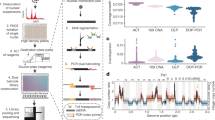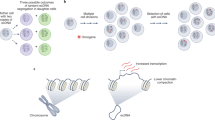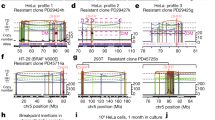Abstract
Mammalian cells selected for resistance to certain cytotoxic drugs frequently develop cross-resistance to a broad spectrum of other drugs unrelated in structure to the original selective agent1,2. This phenomenon constitutes a major problem in cancer chemotherapy. Multi-drug resistance arises from decreased intracellular drug accumulation1–4, apparently due to an alteration of the plasma membrane2,5–7. The observation of double minute chromosomes or homogeneously staining regions in some of the multi-drug-resistant cell lines8–12 suggests that gene amplification underlies this phenomenon. We have used the technique of DNA renaturation in agarose gels13 to detect, compare and clone amplified DNA sequences in Adriamycin- and colchicine-resistant sublines of Chinese hamster cells3,12. We show that both Adriamycin- and colchicine-resistant cells contain amplified DNA fragments, some of which are amplified in both of these independently derived cell lines. Furthermore, loss of the multi-drug resistance phenotype on growth in the absence of drugs correlates with the loss of amplified DNA. These results strongly suggest that the DNA sequences which are amplified in common in multi-drug-resistant cell lines include the gene(s) responsible for a common mechanism of multi-drug resistance in these cells. We have cloned one of the commonly amplified DNA fragments and show that the degree of amplification of this fragment in the cells correlates with the degree of their drug resistance.
This is a preview of subscription content, access via your institution
Access options
Subscribe to this journal
Receive 51 print issues and online access
$199.00 per year
only $3.90 per issue
Buy this article
- Purchase on Springer Link
- Instant access to full article PDF
Prices may be subject to local taxes which are calculated during checkout
Similar content being viewed by others
References
Biedler, J. L., Chang, T., Meyers, M. B., Peterson, R. H. F. & Spengler, B. A. Cancer Treat. Rep. 67, 859–868 (1983).
Ling, V., Kartner, N., Sudo, T., Siminovitch, L. & Riordan, J. R. Cancer Treat. Rep. 67, 869–874 (1983).
Ling, V. & Thompson, L. H. J. cell. Physiol. 83, 103–116 (1974).
Inaba, M., Kobayashi, H., Sakurai, Y. & Johnson, R. K. Cancer Res. 39, 2200–2203 (1979).
Kessel, D. & Bosmann, H. B. Cancer Res. 30, 2695–2701 (1970).
Beck, W. T., Muellen, T. J. & Tanzer, L. R. Cancer Res. 39, 2070–2076 (1979).
Ramu, A., Shan, T. & Glaubiger, D. Cancer Treat. Rep. 67, 895–899 (1983).
Baskin, F., Rosenberg, R. N. & Dev, V. Proc. natn. Acad. Sci. U.S.A. 78, 3654–3658 (1981).
Kopnin, B. P. Cytogenet. Cell Genet. 30, 11–14 (1981).
Kuo, T., Pathak, S., Ramagli, L., Rodriguez, L. & Hsu, T. C. in Gene Amplification (ed. Schimke, R. T.) 53–57 (Cold Spring Harbor Laboratory, New York, 1982).
Grund, S. H., Patil, S. R., Shah, H. O., Pauw, P. G. & Stadler, J. K. Molec. cell. Biol. 3, 1634–1647 (1983).
Howell, N., Belli, T. A., Zaczkiewics, L. T. & Belli, J. A. Cancer Res. (in the press).
Roninson, I. B. Nucleic Acids Res. 11, 5413–5431 (1983).
Tyler-Smith, C. & Bostock, C. J. J. molec. Biol. 153, 203–218 (1981).
Heintz, N. H. & Hamlin, J. L. Proc. natn. Acad. Sci. U.S.A. 79, 4083–4087 (1982).
Dagert, M. & Ehrlich, S. D. Gene 6, 23–28 (1979).
Birnboim, H. C. & Doly, J. Nucleic Acids Res. 7, 1513–1520 (1979).
Southern, E. J. molec. Biol. 98, 503–517 (1975).
Brown, P. C., Tlsty, T. D. & Schimke, R. T. Molec. cell. Biol. 3, 1097–1107 (1983).
Schimke, R. T. (ed.) Gene Amplification (Cold Spring Harbor Laboratory, New York, 1982).
Stark, G. R. A. Rev. Biochem. (in the press).
Riordan, J. R. & Ling, V. J. biol. Chem. 254, 12701–12705 (1979).
Belli, J. A. Front. Radiat. Ther. Oncol. 13, 9–20 (1979).
Blin, N. & Stafford, D. W. Nucleic Acids Res. 3, 2303–2309 (1976).
Rigby, P. W. J., Dieckmann, M., Rhodes, C. & Berg, P. J. molec. Biol. 113, 237–251 (1977).
Kartner, N., Riordan, J. R. & Ling, V. Science 221, 1285–1288 (1983).
Debenham, P. G., Kertner, N., Siminovitch, L., Riordan, J. R. & Ling, V. Molec. cell. Biol. 2, 881–889 (1982).
Author information
Authors and Affiliations
Rights and permissions
About this article
Cite this article
Roninson, I., Abelson, H., Housman, D. et al. Amplification of specific DNA sequences correlates with multi-drug resistance in Chinese hamster cells. Nature 309, 626–628 (1984). https://doi.org/10.1038/309626a0
Received:
Accepted:
Issue Date:
DOI: https://doi.org/10.1038/309626a0
This article is cited by
-
Marine medaka ATP-binding cassette (ABC) superfamily and new insight into teleost Abch nomenclature
Scientific Reports (2015)
-
Synthesis, cytotoxic activity, and computational analysis of N10-substituted acridone analogs
Medicinal Chemistry Research (2015)
-
Expression and significance of hypoxia-inducible factor-1 alpha and MDR1/P-glycoprotein in human colon carcinoma tissue and cells
Journal of Cancer Research and Clinical Oncology (2010)
-
Representational oligonucleotide microarray analysis (ROMA) in pharmacogenomics
The Pharmacogenomics Journal (2004)
-
Maintenance of hypomethylation status and preferential expression of exogenous humanMDR1/PGY1 gene in mouse L cells by YAC mediated transfer
Somatic Cell and Molecular Genetics (1997)
Comments
By submitting a comment you agree to abide by our Terms and Community Guidelines. If you find something abusive or that does not comply with our terms or guidelines please flag it as inappropriate.



